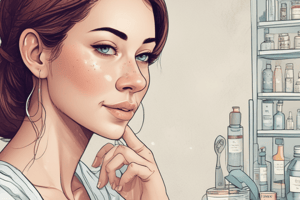Podcast
Questions and Answers
Dè na h-adhbharan a tha gu bhith an làthair ann an deuchainnean a' fhuasglaidh?
Dè na h-adhbharan a tha gu bhith an làthair ann an deuchainnean a' fhuasglaidh?
- Feumalachdan teicnigeach (correct)
- Mì-chliù air clàr eòlais
- Maoin feumail (correct)
- Seachnadh ann an cùisean lagh
C哪个dè an eadar-dhealachadh anns na roinnean?
C哪个dè an eadar-dhealachadh anns na roinnean?
- Ceanglaichean agus eòlas
- Sgiobalta agus seasmhach (correct)
- Bhol agus buailteach
- Dreuchdail agus coitcheann (correct)
Dè an adhbhar nach bu chòir do dh'eisimpleir le duilgheadas a bhith a' freagairt gu furasta?
Dè an adhbhar nach bu chòir do dh'eisimpleir le duilgheadas a bhith a' freagairt gu furasta?
- Furasta a thuigsinn
- Bha e dìreach freagairtean
- Bu chòir a bhith còmhnard
- Dh' fhaodadh e cur ri comas fuasglaidh (correct)
Cò na h-innleachdan a bhios freagairtean a' freagairt ris?
Cò na h-innleachdan a bhios freagairtean a' freagairt ris?
Dè na h-ùidhean a bhiodh air an cur air adhart nuair a bhios a' lìbhrigeadh freagairtean?
Dè na h-ùidhean a bhiodh air an cur air adhart nuair a bhios a' lìbhrigeadh freagairtean?
Flashcards
Oily Skin
Oily Skin
Skin that produces an excess amount of sebum, leading to a shiny appearance and clogged pores.
Open Comedone
Open Comedone
A clogged pore with a large opening, allowing for the accumulation of sebum and dead skin cells.
Pustule
Pustule
A red pimple containing pus, often caused by inflammation and infection.
Hyperpigmentation
Hyperpigmentation
Signup and view all the flashcards
Exfoliation
Exfoliation
Signup and view all the flashcards
Study Notes
Exam 13 - Multiple Choice Questions
- Obvious pores on skin: Indicate oily skin areas, not dry, alipidic or comedones.
- Dry skin: Also known as alipidic skin, as it doesn't produce enough sebum.
- Shiny/greasy skin: Indicates clogged follicles, from dead cells. This is oily skin.
- Closed vs Open Comedones: Difference is in the size of the follicle opening; closed are smaller.
- Acne bacteria: Anaerobic meaning they cannot survive in the presence of oxygen.
- Pimple with pus: Called a pustule, not a comedone, rosacea, or ostrum.
- Dark skin discoloration: Caused by sun exposure or hormonal imbalances, called hyperpigmentation.
- Skin treatments to avoid: Heat or stimulating treatments for clients with hyperpigmentation.
Skin Care Products & Procedures
- Foaming cleansers: Contain surfactants, a type of detergent.
- Products for pH balance: Toners and peels. They remove residues and balance the skin's pH.
- Dead skin removal products: Cosmetologists are only allowed to use products that remove dead skin from the stratum corneum, not stratum granulosum or lucidum.
- Dead cell removal process: Called exfoliation, not toning or peels itself.
- Cream-type enzyme application: Called Gommage.
- Exfoliants: Dissolve bonds between cells, such as alpha hydroxy acids (AHAs).
- Chemical exfoliants: Often called enzyme peels, which dissolve keratin proteins.
- Moisturizers: Increase skin surface water content, which have water-binding agents (humectants), and are also high concentration products (serums).
Massage Techniques & Products
- Cream removal: Massage cream must be removed before applying other products.
- Masks: Clay-based masks are oil-absorbing and astringent.
- Modelage masks: Are special masks that contain crystals and dry into a plaster-like consistency.
- Massage fabric: Gauze is a thin, open-meshed cotton fabric used to hold mask products.
- Massage manipulation: Depends on pressure, direction of movement, and duration of manipulation.
- Stroking massage: Called effleurage.
- Kneading massage: Called petrissage.
- Deep rubbing: Called friction.
- Short, quick tapping: Called tapotement.
- Muscle pressure point: Motor point.
- Skin softening: Facial steamer is used to soften skin.
- Applicator: Electrode, used to direct electric current.
Additional Skin & Makeup Information
- Oil or fatty ingredients (EM): Preventive moisture from leaving the skin.
- Dilated blood vessels: Telangiectasias.
- Chopping / rolling motions: Hacking or rolling, respectively.
- Skin discoloration, disguised: Color primer cancels out discoloration.
- Foundation types: Liquid, cream and mineral-based powder.
- Eye makeup: Lighter color for highlighting, darker color for contouring.
- Lip liner: Cosmetic used to outline the lips.
- Eye liner: Cosmetic used for outlining and emphasizing the eyes.
- Facial shape considerations: Oval is most ideal shape.
- Makeup blending tool: Spatula, sponges, etc.
- Makeup application method: Using a translucent powder for setting makeup, in order to prevent it from transferring onto clothes etc.
Makeup Tools & Techniques
- Eye Pencil Application: Never apply to the inner rim of the eye.
- Makeup Brushes: Can be cleaned using a brush solvent or gentle shampoo.
- Color Theory: Important in makeup applications.
- Skin Tone: Skin color, eye color, and hair color are all factors for determining proper makeup colors.
- Foundation: Used to color or even out skin coloring.
Studying That Suits You
Use AI to generate personalized quizzes and flashcards to suit your learning preferences.




